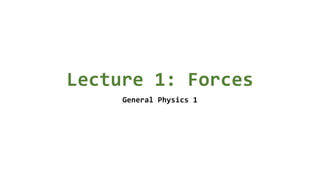
P6_Lecture-1.pptx
- 1. Lecture 1: Forces General Physics 1
- 2. Learning Outcomes: At the end of this section, you’ll be able to: • understand what a force is. • describe some types of forces • Treat bodies as point particles. • Construct and interpret free-body force diagrams. • Apply the equilibrium condition, ΣF = 0. • Understand and apply Newton’s three laws of motion. • Solve problems involving solid friction.
- 4. What types of forces are there?
- 6. • In each of the four examples given, there is a change in the motion of the object. • The velocity of an object changes with time i.e. there is acceleration. • A force can cause an object to accelerate or decelerate.
- 10. Newton’s first Law of Motion is also known as the Law of Inertia.
- 11. Unbalanced Forces and Newton’s Second Law If the resultant force acting on an object is not zero, we say the forces are unbalanced. Forces cause the book to accelerate or decelerate.
- 12. Unbalanced Forces and Newton’s Second Law • Unbalanced forces causes an object to accelerate, decelerate or change direction. • The direction of acceleration is in the direction of the resultant force. Unbalanced forces and their relation to Newton’s Second Law
- 19. The force that arises in any body when it is stretched is called tension. A string that is taut is said to be under tension. The tension force is the result of electromagnetic interactions between the molecules of the material making up the string.
- 21. Normal reaction contact forces If a body touches another body, there is a force of reaction or contact force between the two bodies. This force is perpendicular to the surface of the body exerting the force.
- 22. Drag forces are forces that oppose the motion of a body through a fluid (a gas or a liquid). Typical examples are the air resistance force experienced by a car (Figure 2.31) or plane, or the resistance force experienced by a steel marble dropped into a jar of honey. Drag forces are directed opposite to the velocity of the body and in general depend on the speed and shape of the body. The higher the speed, the higher the drag force.
- 23. Upthrust Any object placed in a fluid experiences an upward force called upthrust (Figure 2.32). If the upthrust force equals the weight of the body, the body will float in the fluid. If the upthrust is less than the weight, the body will sink. Upthrust is caused by the pressure that the fluid exerts on the body.
- 24. Frictional forces Frictional forces generally oppose the motion of a body (Figure 2.33). These forces are also electromagnetic in origin. Figure 2.33 Examples of frictional forces, f. In (a) there is motion to the right, which is opposed by a single frictional force that will eventually stop the body. In (b) the force accelerating the body is opposed by a frictional force. In (c) the body does not move; but it does have a tendency to move down the plane and so a frictional force directed up the plane opposes this tendency, keeping the body in equilibrium.
- 28. Friction that occurs between two bodies in contact with one another while they are at rest. Its friction which prevents an object from moving while it is still Friction that opposes the movement of a body which is already in motion. Its friction that slows or stops an object from moving.
- 30. Equilibrium Equilibrium of a point particle means that the net force on the particle is zero. The net force on a particle is the one single force whose effect is the same as the combined effect of individual forces acting on the particle. We denote it by ΣF. Finding the net force is easy when the forces are in the same or opposite directions (Figure 2.43).